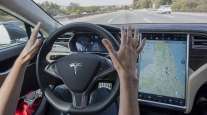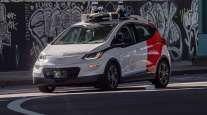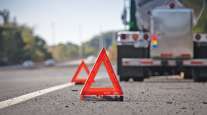Self-Driving Cars Are On North Carolina Turnpike Authority’s Radar

The fatal crash involving an Uber self-driving car in Arizona last month has not dissuaded the North Carolina Turnpike Authority from urging companies to test autonomous vehicles on the Triangle Expressway in western Wake County.
The toll road that runs from Research Triangle Park south to Holly Springs is one of 10 places around the country and the only one in North Carolina that the U.S. Department of Transportation has designated as “proving grounds” for automated vehicles. The federal government chose the 10 from more than 60 groups that wanted to host autonomous vehicle testing.
RELATED: Uber crash sparks talk of tighter rules for self-driving vehicles
The Turnpike Authority and the N.C. Department of Transportation say hosting a site for autonomous vehicle testing will allow them to learn about technology that is showing up on the state’s highways and will only become more common and sophisticated. By having the testing done here, highway engineers can learn from the car companies what changes may be needed to pavement markings, signs and other aspects of a road to ensure the technology works as intended, said Dennis Jernigan, the Turnpike Authority’s director of highway operations.
RELATED: Uber isolated by partners and competitors in aftermath of crash
“We want to know that so that when this technology really starts to flood the market, we know we’re ahead of the game — we’re ready,” Jernigan said.
So far, no company has opted to test its vehicles on the Triangle Expressway. Jernigan said the state and its five university research partners — N.C. State, UNC-Chapel Hill, Duke, N.C. A&T and UNC Charlotte — are actively marketing the expressway as well as an independent nonprofit off-road testing site near Roanoke Rapids, the N.C. Center for Automotive Research.
They are touting the expressway as one of the most advanced freeways in the country. It has a fiber optic network along its 19-mile length used for electronic tolling as well as the video cameras and in-pavement detectors that help the Turnpike Authority monitor conditions on the highway from a 24-hour traffic management center in Raleigh.
RELATED: Toyota warns that some rivals are skipping steps in race to autonomy
But companies that want to see how their self-driving technology works on the road are not restricted to the federally designated proving grounds. None of the sites is in Arizona, for example, but state officials there, led by Gov. Doug Ducey, have actively wooed companies such as Uber, Lyft, General Motors, Intel and Waymo to come test their technology on public streets.
North Carolina is not trying to emulate Arizona or any of the other places where this kind of testing has been taking place.
“We’re not trying to be the No. 1 location for autonomous vehicle testing in North America,” Jernigan said. “We’re trying to make the industry know that we are willing to consider testing equipment and technology on our roadways.”
RELATED: Uber crash is nightmare driverless world feared but expected
The technology that will allow cars to drive themselves is mostly being developed elsewhere. Getting the companies to come test it in the Triangle would allow university researchers and NCDOT engineers to get more involved in the field and help North Carolina adapt, said Thomas Chase, a researcher at NCSU’s Institute for Transportation Research and Education who specializes in autonomous vehicles.
There are risks with any vehicle testing, Chase says, but he thinks the six-lane Triangle Expressway is a safe place to do it.
“The expressway has well-maintained lane markings and consistent geometric features which should be easier for initial AV systems to navigate,” he wrote in an e-mail.
Chase notes that the promise of autonomous vehicles is much greater safety; more than 90% of crashes are caused at least in part by human error.
“However, AVs tested on public roads will be mixing with human-driven vehicles, so it won’t be possible to prevent all crashes,” he wrote.

This March 19, 2018 still image taken from video provided by ABC-15, shows investigators at the scene of a fatal accident involving a self-driving Uber car on the street in Tempe, Ariz. (ABC-15.com via AP)
The fatal collision in Arizona was apparently the result of human and technological error, both within the self-driving Volvo being tested by Uber. On the night of March 18, the car struck and killed 49-year-old Elaine Herzberg as she wheeled a bicycle across a street in Tempe. Not only did the car fail to detect Herzberg, but dash-cam video showed the test driver looking away from the road just before the collision. (Ducey has since ordered Uber banned from future tests in the state because of the company’s “unquestionable failure” to safeguard public safety.)
Jernigan says that before any testing is done on the Triangle Expressway, the Turnpike Authority will require companies to submit a “testing plan, a plan we have to be comfortable with that’s not going to put anyone at risk.”
He said the accident in Tempe has not come up in conversations with prospective testers on the highway.
“That was an urban test. We’re more of an open-road facility.” Jernigan said.
“The stage is now set for what will essentially be beta-testing on public roads with families as unwitting crash test dummies,” said a letter to U.S. Senate leaders from representatives of 19 organizations. Among the signers was Joan Claybrook, the former National Highway Traffic Safety administrator under President Jimmy Carter who went on to head the advocacy group Public Citizen.
But the Turnpike Authority hasn’t ignored the Arizona accident, spokeswoman Carly Olexik said.
“Anytime there is a loss of life, we take the situation seriously and reflect on it to see if there are lessons learned that we should apply,” Olexik wrote in an e-mail. “We are committed to ensuring the safety of our customers, and we will vigorously vet any proposal to test this technology on our facility.”
So far, the only vehicle with self-driving technology to be tested on the Triangle Expressway is a Cadillac CT6 that the Turnpike Authority borrowed from General Motors Co. for a month this winter.
The Cadillac’s Super Cruise system, already on the market, allows the car to move down major highways without the driver touching the accelerator or the steering wheel. The car maintains its speed, stays in its lane and keeps its distance from a vehicle in front of it on open freeways that GM has mapped and loaded into Super Cruise.
If the car encounters anything that the driver needs to handle, such as an exit ramp, a toll booth or a construction zone, the green light that indicates the system is on turns red, the seat vibrates and the car turns control back over to the driver. If the driver fails to respond, the car stops, still in its lane.
Even when Super Cruise is on, the Cadillac requires the driver to pay attention. The car watches the driver’s eyes from a camera inside the top of the steering wheel and will warn him if he’s taken his eyes off the road for too long.
Distributed by Tribune Content Agency, LLC




